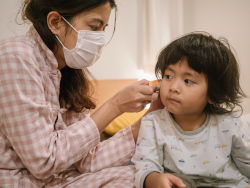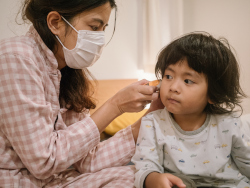A new University of Florida epidemiological study, based on contact tracing data from thousands of households in Wuhan, China, finds that while children are less susceptible to COVID-19, when they do become infected they can be nearly 60% more likely than adults over 60 to infect exposed family members.
The findings, which appear in Lancet Infectious Diseases, emphasize the need to conduct COVID-19 vaccine safety and efficacy studies in children, said Yang Yang, Ph.D., one of the study’s senior authors and an associate professor of biostatistics in the UF College of Public Health and Health Professions and the UF College of Medicine, part of UF Health.
“We also need to take into account the potential high infectivity of children when we plan school re-openings and what prevention measures we need to take during active school sessions,” said Yang, a member of UF’s Emerging Pathogens Institute.
Previous studies have found children shed SARS-CoV-2, the virus that causes COVID-19, at similar rates as adults, so their higher infectivity may be due to their level of close contact with parents and other relatives who care for them, the researchers believe. The overall contribution of child cases to household transmission was still limited, the study determined, as children were isolated faster than adults who were infected.
The new study also found infants under the age of 1 were significantly more likely to be infected with COVID-19 than children between the ages of 2 and 5. This may be due to a combination of their still-developing immune systems and their close contact with adults.
“It’s unlikely there will be a vaccine for infants against COVID-19 in the near future, so we need to protect their caregivers,” said Ira Longini, Ph.D., a study co-author and a UF professor of biostatistics. “We may want to prioritize caregivers for COVID-19 vaccination to protect infants indirectly because we don’t really know the long-term consequences of infection, especially in infants.”
The study found that people who were asymptomatic during the whole course of their infection were 80% less infectious than people with symptoms. In addition, presymptomatic people were about 40% more infectious than symptomatic ones.
For the study, UF and Chinese investigators, including researchers at the Wuhan Center for Disease Control and Prevention and Huazhong University of Science and Technology, used a statistical transmission model to analyze data from more than 27,000 households in Wuhan, the first epicenter of the COVID-19 outbreak. The data included households of all laboratory-confirmed or clinically confirmed COVID-19 cases and laboratory-confirmed asymptomatic infections identified by the Wuhan Center for Disease Control and Prevention between Dec. 2, 2019 and April 18, 2020, a peak period of COVID-19 disease transmission in that city.
In addition to Yang and Longini, UF study team members included Ming-Jin Liu, a Ph.D. student in statistics and one of the study’s lead authors, and Natalie Dean, Ph.D., an assistant professor of biostatistics.
Additional key findings from the team’s study include:
-The secondary attack rate — the probability that a person with COVID-19 will infect another member of their household — was 15.6%, a rate similar to other respiratory pathogens.
-Older adults were more likely to become infected than younger household members, especially those under age 20.
-While children were less susceptible to COVID-19 infection than adults and they generally experienced less severe symptoms, they were just as likely to develop symptoms as adults.
In China, centralized isolation and quarantine programs that placed infected individuals or close contacts in health care facilities, hotels or university dorms helped to significantly lower household transmission rates when they were implemented later in the outbreak, but that strategy isn’t feasible in many countries, Yang said.
“I recommend following CDC guidelines and taking extra caution when a household or family member is infected,” Yang said. “This includes wearing masks if someone in the family has symptoms, especially when you need to be in close contact, good hand hygiene, surface cleaning and COVID-19 testing of asymptomatic members of the household, if possible.”
The UF team’s study funding was provided by the National Institutes of Health and the National Science Foundation.
This story originally appeared on UF Health.
Check out stories about UF research on COVID-19.


